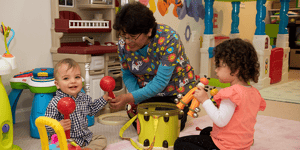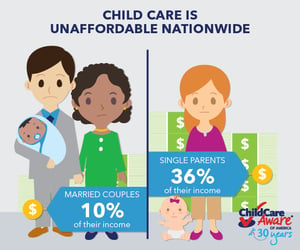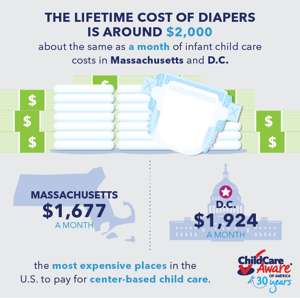 That’s the bottom line from CCAoA’s just-published report on Parents and the High Cost of Child Care: 2017. Our signature annual report is now in its eleventh year and this year, as in previous years, child care represents one of the most significant expenses in parents’ budgets. In all regions of the country, families average child care fees for an infant in a child care center are more than the average amount that families spend on food and transportation combined. And the average annual cost for an infant in center-based care was higher than a year’s tuition and fees at a four-year public college in 28 states and the District of Columbia!
That’s the bottom line from CCAoA’s just-published report on Parents and the High Cost of Child Care: 2017. Our signature annual report is now in its eleventh year and this year, as in previous years, child care represents one of the most significant expenses in parents’ budgets. In all regions of the country, families average child care fees for an infant in a child care center are more than the average amount that families spend on food and transportation combined. And the average annual cost for an infant in center-based care was higher than a year’s tuition and fees at a four-year public college in 28 states and the District of Columbia!
So what exactly do we mean by ‘unaffordable?’
In 2016, the U.S. Department of Health and Human Services (HHS) made a recommendation that child care should cost a household no more than seven percent of a family’s average income. Anything higher would be considered unaffordable. For the report, we took the average cost of child care in a state and divided that number by the state’s average household income. Doing so gave us the percentage of household income, on average, that was spent on child care. By HHS’s measure, child care is unaffordable in every single state and the District of Columbia.
While paying for child care is a hardship for most families, it is especially problematic for low-income families and single working parents. Increasing access to, and the affordability of, quality child care for these Americans must become a national priority. Right now, a single parent who works and has an infant in a child care center pays more than 27 percent of household income for care – and that is unacceptable.
One Parent's Struggle
But it’s what Daniela Salinas experienced. When her son was a month old, Daniela placed him in care. She was a single mom who worked and was pursuing a master’s degree. She worried that most of her income went to paying for child care. Daniela views quality, affordable child care as essential for single working mothers if they are to raise healthy children who become productive, self-sufficient adults.
We encourage you to dive into Parents and the High Cost of Child Care: 2017. If you’ve read previous editions of the report, you’ll notice some changes, namely:
 This year’s report is streamlined. It’s more narrowly focused on cost and the strategies that states and communities are using to help parents afford child care.
This year’s report is streamlined. It’s more narrowly focused on cost and the strategies that states and communities are using to help parents afford child care.- There’s an updated interactive map with county-level data for seven states: Hawaii, Arizona, Massachusetts, Delaware, Minnesota, Alaska, and New Hampshire.
- Rather than grouping infant and toddler costs together, we give separate data for infant costs and toddler costs.
- We share some new information on summer care costs.
We are going to keep the child care cost and affordability drumbeat going throughout 2018. We’ll be releasing briefs, case studies, maps, webinars, etc., all related to the high cost of child care. Please join us in that conversation and check out Parents and the High Cost of Child Care: 2017!






